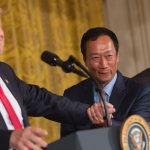What’s going on with Detroit area Democrats?
Discouraged, downtrodden – that may be the state of the Democratic Party in the region after the feeble turnout, just 4,000, at the Women’s March in the Motor City on Saturday. That is a tiny fraction of the attendance in other big cities across the nation and smaller than the crowds in many mid-sized communities.
In comparison, Lansing had an estimated 8,000 to 10,000 and Traverse City was not far behind Motown at 3,000. Across the country, the Detroit march was put to shame by cities such as Des Moines, IA, (26,000), Asheville, N.C. (7,000-10,000), Colorado Springs, CO, (7,000), and Omaha, NE, (12,000-14,000).
Those numbers are based on a project by a couple of professors, from the University of Connecticut and the University of Denver, who are compiling attendance figures from the hundreds of Women’s Marches held across the nation. With help of a team of volunteers, they are assembling high and low estimates from each site based mostly on news reports, though some of the data from small gatherings is simply collected from Facebook and Twitter posts.
Detroit participants marched on Woodward adjacent to Wayne State University. Campus police estimated the Detroit crowd at “well over 4,000,” according to The Detroit News, so the true number was probably higher.
Nonetheless, this “Sister March” was undeniably low on a day when the national total was estimated by the professors at between 3.3 million and 4.6 million.
The state Democratic Party already was concerned about the nosedive in Hillary Clinton’s Election Day vote tallies in Wayne County compared to Barack Obama’s showing four years earlier. Clinton’s support among women statewide was far below what polls had shown prior to the election. So, Saturday’s march should have party leaders scratching their heads even more than before.
It could be that the Detroit event was poorly organized or insufficiently publicized. But the news coverage leading up to the marches – and the historic crowds reported on TV as the demonstrations began Saturday morning – should have inspired women, liberals and Democrats of all kinds to head out the door.
Weather certainly was not a factor. Those in Metro Detroit who were on the fence about attending surely should have been encouraged by the extraordinary January conditions – 52 degrees and (eventually) a rare showing by the sun.
But objective observers would have to agree: For Democrats, it appears it’s mostly cloudy and gloomy in Detroit these days.
*****
For those still interested in debating crowd sizes, Nate Silver of Five Thirty Eight tackled the issue and came up with a nationwide estimate of at least 3.2 million marchers, about 10 times the size of the big tea party rallies in 2009.
Here’s how he explained his analysis:
Overall, we found 11 (large) cities where there were separate estimates of crowd sizes given by organizers and local officials. They followed a remarkably consistent pattern: In all cases, the estimate by local officials was 50 to 70 percent as high as the one given by march organizers. Or put another way, the estimates produced by organizers probably exaggerated crowd sizes by 40 percent to 100 percent, depending on the city.
… For most of the largest marches, we were able to identify a crowd-size estimate from public agencies, such as a police department or a mayor’s office, or which was provided by nonpartisan experts who sought to estimate crowd sizes using photography or other techniques. Where we weren’t able to find such sources, we discounted the reported march sizes by 40 percent if they were based on estimates given by organizers or by 20 percent if a news account’s sourcing was ambiguous.
Even with this relatively cautious approach, we estimated the aggregate crowd size at 3.2 million people among the roughly 300 U.S. march sites for which we were able to find data. Our estimate of 3.2 million marchers is lower than other estimates that take organizer-provided estimates at face value, but is nonetheless an impressive figure. By comparison, using a similar technique, we estimated the tea party rallies on April 15, 2009, drew around 310,000 participants among about 350 cities.
Photo: Jason Scott/WWJ Newsradio 950










It is absolutely because of poor organization and not publicized. I looked for it on Google, facebook and only the Lansing and Traverse city march info came up. I watched the local news which made no mention of any march in Detroit. A quick ask of friends after reading this confirms that they knew nothing of it, but knew of one in neighboring Grosse Pointe that attracted over 1000 people. Not good organization for Detroit at all. Too bad.